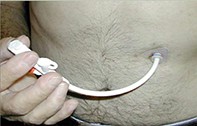Peer Reviewed
Gastroenterology clinic
Managing patients with a PEG
Abstract
Enteral feeding via a percutaneous endoscopic gastrostomy (PEG) can improve a patient’s gross nutritional deficiencies and maintain his or her quality of life.
Key Points
- Malnutrition contributes to higher mortality and risks of infection. Enteral feeding is a safe and effective way to obtain nutrition in a functioning gut when a patient cannot eat or drink sufficiently for survival.
- Patients to be considered for enteral feeding via percutaneous endoscopic gastrostomy (PEG) include: those with swallowing difficulties due to progressive neurological disorders such as motor neurone disease; those who cannot safely swallow because of neurological injury such as cerebrovascular injury or trauma, or oesophageal obstruction due to inoperable malignancy; those unable to maintain nutrition due to chronic illness such as cystic fibrosis.
Remember
Purchase the PDF version of this article
Already a subscriber? Login here.

